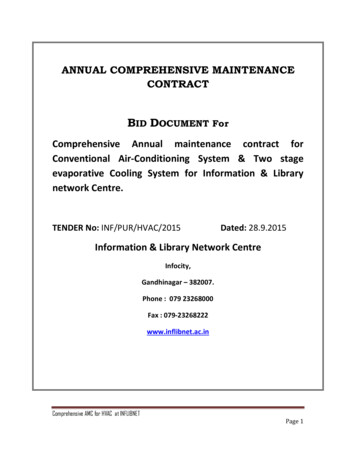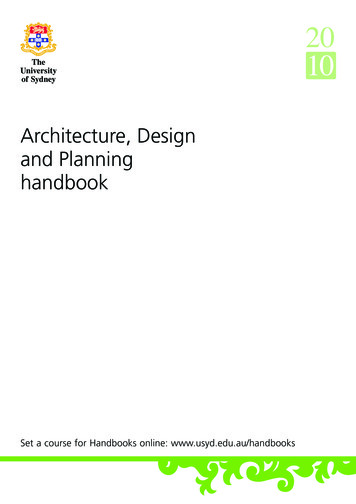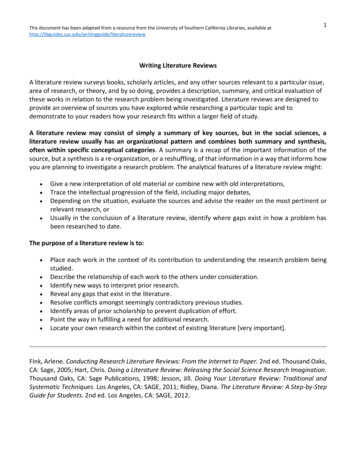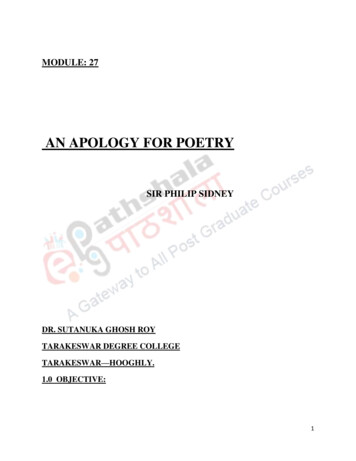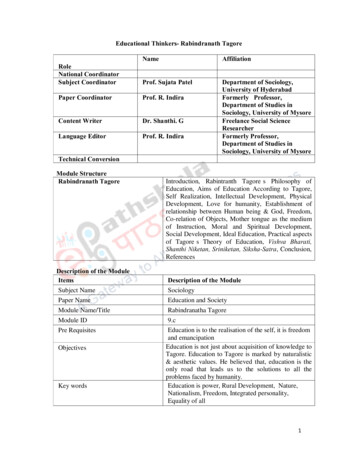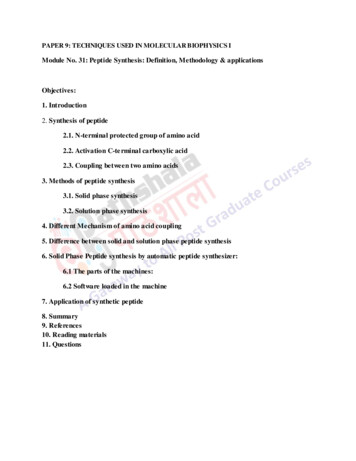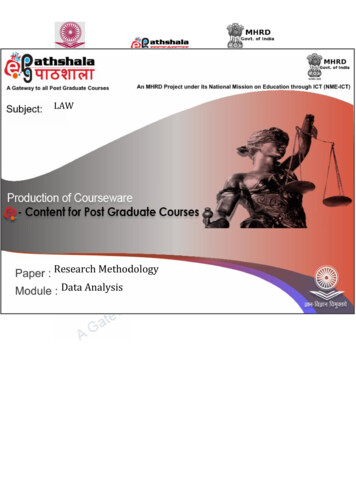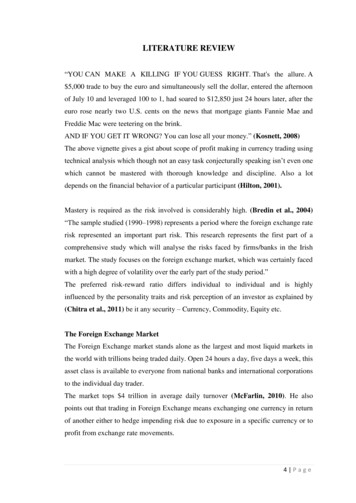
Transcription
LITERATURE REVIEW“YOU CAN MAKE A KILLING IF YOU GUESS RIGHT. That's the allure. A 5,000 trade to buy the euro and simultaneously sell the dollar, entered the afternoonof July 10 and leveraged 100 to 1, had soared to 12,850 just 24 hours later, after theeuro rose nearly two U.S. cents on the news that mortgage giants Fannie Mae andFreddie Mac were teetering on the brink.AND IF YOU GET IT WRONG? You can lose all your money.” (Kosnett, 2008)The above vignette gives a gist about scope of profit making in currency trading usingtechnical analysis which though not an easy task conjecturally speaking isn‟t even onewhich cannot be mastered with thorough knowledge and discipline. Also a lotdepends on the financial behavior of a particular participant (Hilton, 2001).Mastery is required as the risk involved is considerably high. (Bredin et al., 2004)“The sample studied (1990–1998) represents a period where the foreign exchange raterisk represented an important part risk. This research represents the first part of acomprehensive study which will analyse the risks faced by firms/banks in the Irishmarket. The study focuses on the foreign exchange market, which was certainly facedwith a high degree of volatility over the early part of the study period.”The preferred risk-reward ratio differs individual to individual and is highlyinfluenced by the personality traits and risk perception of an investor as explained by(Chitra et al., 2011) be it any security – Currency, Commodity, Equity etc.The Foreign Exchange MarketThe Foreign Exchange market stands alone as the largest and most liquid markets inthe world with trillions being traded daily. Open 24 hours a day, five days a week, thisasset class is available to everyone from national banks and international corporationsto the individual day trader.The market tops 4 trillion in average daily turnover (McFarlin, 2010). He alsopoints out that trading in Foreign Exchange means exchanging one currency in returnof another either to hedge impending risk due to exposure in a specific currency or toprofit from exchange rate movements.4 Page
The currency can be traded either in the Spot Market, Forwards/Futures market,ETF‟s or Options Market. It was found that recently the spot market dominates pricediscovery (Rosenberg, 2009).Till date, many traders mostly trade certain currencies vs. the U.S. dollar only. Thatrestricts the trades to dollar fundamentals, sometimes at the expense of thefundamentals of the other side of the trade. Traders can even expand theiropportunities by trading cross pairs where in US Dollar has been used as a vehiclecurrency (Chelkowski, 2010).Glen Arnold et al. in the book Corporate Financial Management have highlighted thatin the Foreign Exchange market most of the trades are between banks for speculationrather than for underlying export or import. The results of the study done by(Ramcharran, 2000) signify this as it shows a strong relationship between the tradingincome of banks and exchange rate volatility.But those trades that are done against genuine exposure can affect the followingentities:1. Receipts for Export2. Payment of Imports3. Valuation of foreign assets and liabilities4. Long-term viability of overseas operations5. Feasibility of a foreign projectAdditionally, even if one does not trade in Foreign Exchange Market directly, thevalue of any currency in terms of another can sometimes affect the market you watchmore than any other variable (Murphy, 2004).Believers of random-walk theory say that investors can't beat the stock marketbecause news travels too rapidly. When a new bit of information emerges, investorsreact to it almost instantly, bidding a stock's price up or down until it reaches a newequilibrium. Therefore, the only things that the market hasn't taken into account arethings that haven't happened yet. Those events are, by definition, random. Thus inother words, they believe that any amount reasoning cannot help in predicting themarket (Coy, 1999).5 Page
But those who do reason they do it either fundamentally or technically. These are theones who believe that an informationally efficient market reflects relevant informationfully and promptly (Liu, 2007).And some do it really well,Investigation of an index of returns on professionally managed currency fundsshowed that over the 1990-2006 period, currency fund managers earned excessreturns averaging 25 bps per month using 4 distinct styles of currency trading - carry,trend, value, and volatility. The study also inferred that Trend strategies havecelebrated an unexpected revival (Levich et al., 2008).Forecasting Markets - Fundamental Factors versus Technical IndicatorsFundamental analysis is a method of evaluating securities by attempting to measurethe intrinsic value of a stock. Fundamental analysts study everything from the overalleconomy and industry conditions to the financial condition and management ofcompanies.On the other hand, Technical analysis is the evaluation of securities/assets by meansof studying statistics generated by market activity, such as past prices and volume.Technical analysts do not attempt to measure a security's intrinsic value but insteaduse charts to identify patterns and trends that may suggest what the security will do inthe future. (Venkatesh et al., 2011) and (Talati, 2002)One type of technical Analysis - Elliott Wave Theory claims that the movement of thestock market could be predicted by observing and identifying a repetitive pattern ofwaves thus helping the trader and investor to reduce risk and maximize profit(Dharmaraj et al, 2011). Same are the uses of any other type of technical analysistool. In other words, Technical analysis focuses exclusively on the study of marketaction while fundamental analysis focuses on the underlying economic forces ofsupply and demand that cause prices to move up or down or stay the same.In accepting the premise of technical analysis, one can see why technicians believetheir approach is superior to the fundamentalists. If the fundamentals are reflected inmarket price, then the study of those fundamentals becomes unnecessary (Murphy,1999).6 Page
Technical AnalysisTechnical analysis is a constantly evolving emerging science because quantitativemethods for evaluating price movement to make trading decisions have now become adominant part of current market analysis.Detecting new trends early using mechanical trading rules in technical analysis is oneof the techniques that professional traders use to make abnormal returns above thebenchmark return of the passive buy-and-hold policy (Azizan et al., 2010).Rationale of Technical Approach of ForecastingMost technical chartists concur that much of what we call Technical Analysis todayhas its origins in theories first proposed by Dow around the turn of the century. DowTheory still forms the cornerstone of the study of technical analysis, even in the faceof today‟s sophisticated computer technology, and the proliferation of newer andsupposedly better technical indicators (John Murphy, 1999).(Krishnan et al., 2009) very clearly indicate that technical analysis is profitable incurrency trading in foreign exchange spot market, which is proven by the fact that allthe four currency pairs, six time frames and ten indicators under consideration yieldedtrading profits in foreign spot market.(Bettman et al., 2009) state that, “Testing confirm the complementary nature offundamental and technical analysis by showing that, although each performs well inisolation, models integrating both have superior explanatory power.”In another paper (Caginalp et al., 1998) evidence is provided that traders are influenced byprice behavior in short term.The results of the study conducted by (Okunev et al., 2003) indicates that the potential existsfor investors to generate excess returns in foreign exchange markets by adopting a momentumstrategy using the moving average rules identified in this paper. It is not at all apparent thatforeign exchange markets operate in an efficient manner and that returns are determinedentirely by fundamental information. In fact, very simple technical rules can generate quitesignificant returns beyond those that can be explained by transactions costs or risk.(Venkatesh et al., 2011) inferred that at shorter horizons there exists a skew towards relianceon Technical Analysis, while the skewness moves towards fundamental analysis for long termInvestments.Trend strategies applied to currencies show the best results over medium-term rebalancingcycles of 3–6 months (Mettler et al., 2010).7 Page
(Middleton, 2005) also cites that trend trading remains a dominant style of managingcurrencies.People still keep on raising doubts about the trending of the currency market andwhether charts can be used to forecast future movements. The profitability oftechnical currency trading has been declining since the late 1980s (Schulmeister,2008). There is evidence that there are lower returns from trend-trading than before,but the recent trading profits for exotic currencies are still attractive (Pukthuanthonget al,. 2007).Japanese Candlestick as a Technical Analysis Tool:(Steve Nison,2001) in his book on Japanese candlestick techniques mentions thatJapanese Candlestick technique is a versatile tool that can be fused with any othertechnical tool, and will help improve any technician's market analysis.Some researchers (Northcott, 2009) provide a warning that candlesticks should neverbe used alone to make a trading decision. They don‟t show enough about the rest ofthe price activity, and their interpretation often depends on the trend they are in. Oneshould determine the overall market position using conventional technical indicatorsbefore entering into a trade. Candlesticks work best at indicating reversal points whenthe price is overbought or oversold, in which case they can help with the timing ofyour entry. In this situation, a Doji candle indicates that no one is in charge, neitherbulls nor bears, so the trend is neutral. Individual candlesticks such as the hangingman and hammer formations display a wealth of information and can indicate theprobability of a one-day reversal, but there is also the possibility that they couldsimply be outliers, so patterns made of multiple candlesticks can offer confirmationthat the reversal is real (McMahon, 2007).There are hundreds of named candlestick patterns, but many traders choose a few thatseem to work best for them in the markets they trade. The successful interpretation ofthem all comes back to the basic ideas expressed above (Northcott, 2009). Which ofthese are best suited for the Indian market is what this paper intends to find out. Also,whether the Japanese Candlestick work in the Indian Currency market by itself, or dothey need support of Western Technical Indicators and Fundamental factors is anotheraspect that will be interrogated.8 Page
Technical Analysis in Indian ContextThough the basic tenets of trading using any technical indicator should generallyremain the same, it may at times vary depending upon the convertibility of a currencyand maturity of the market.For India it may depend on things like the trends in inflows of foreign capital into thecountry. It is also known that, Reserve Bank of India often prevents the exchange rateappreciation associated with rising capital inflows by accumulating foreign exchangereserves and foreign investments (Singh et al, 2010). Similarly, Reserve Bank ofIndia at times also prevents depreciation. It is thus necessary to study the CandlestickCharting Techniques in Indian context and develop suitable strategies as at this pointof time India is still in the transition stage to fuller openness (Chakravarty, 2011).9 Page
bulls nor bears, so the trend is neutral. Individual candlesticks such as the hanging man and hammer formations display a wealth of information and can indicate the probability of a one-day reversal, but there is also the possibility that they could simply be outliers, so patterns made of multiple candlesticks can offer confirmation
